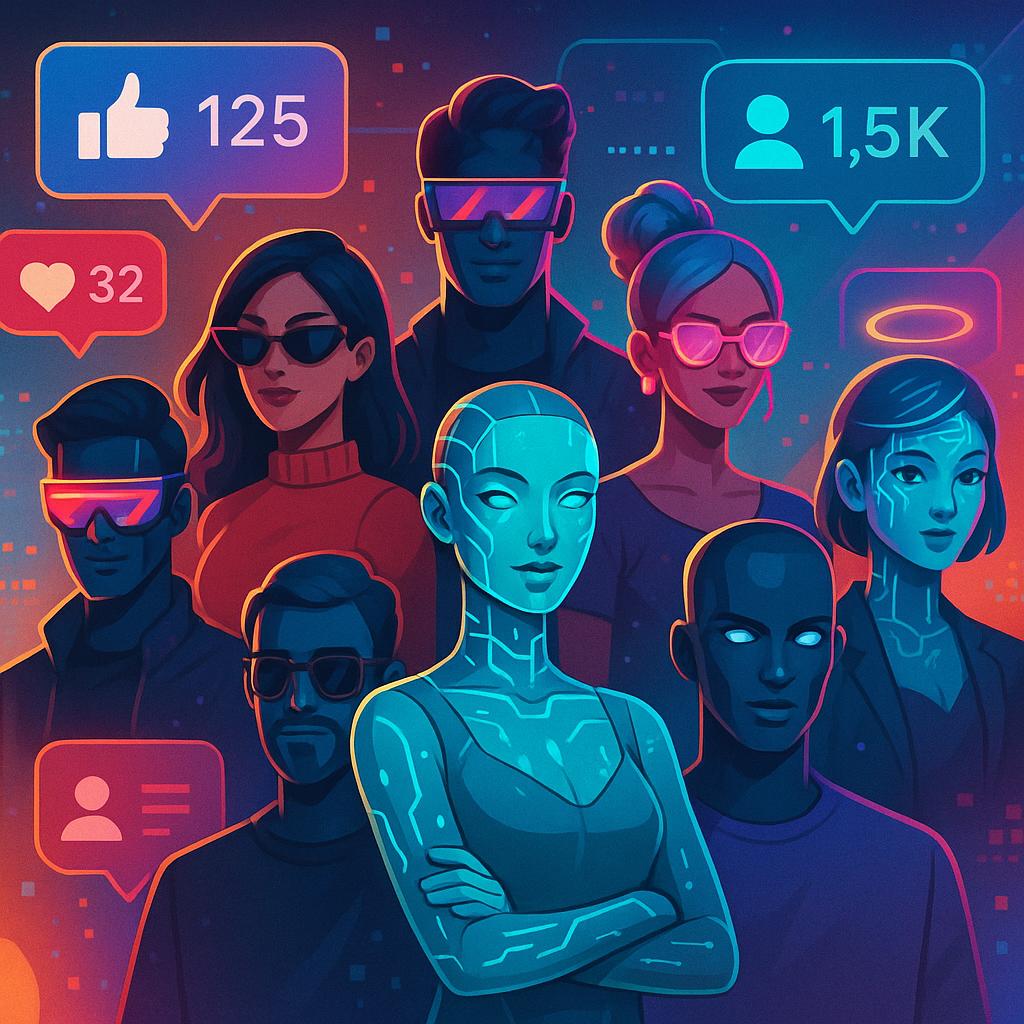She’s standing on a balcony in Santorini, sunlight catching the rim of her iced coffee as she tilts her phone for the perfect shot. A few hours later, her post racks up more than 200,000 likes, a mix of outfit tags, travel envy, and heart emojis from followers who can’t get enough of her style.
There’s just one detail most of them don’t know: she isn’t real.
Her name, face, and voice are entirely created by artificial intelligence. The brand deal is real, the engagement is real, but the influencer is digital.
AI influencers are now part of the marketing ecosystem, working alongside or even replacing humans.
The shift raises real questions for marketers. What works better for a specific goal: a CGI avatar or a human creator? What are the tradeoffs around cost, control, and credibility? This guide breaks it down with practical comparisons, examples, and a simple decision path any team can use.
What Makes an Influencer Effective for Business
Influencer marketing has become one of the most effective ways for brands to reach audiences online.
Instead of relying on traditional ads, companies partner with individuals who already have loyal followings and credibility in specific niches. These influencers bridge the gap between brands and consumers, presenting products through lifestyle and authenticity.
The strategy works because people relate more easily to other people than to corporate messages, or at least they used to.
Influencer effectiveness is less about fame and more about fit. The best programs align creator, content, and conversion path.
- Audience fit: real overlap with ideal customer profile, not just raw follower count.
- Credibility: topic authority, content quality, and comment sentiment.
- Format strength: short video, Stories, livestreams, or long-form explainers.
- Storyline: a narrative that connects the product to a believable outcome.
- Measurable path: tracked links, discount codes, or lead forms set up in advance.
- Operational readiness: reviews, approvals, and post-campaign reporting baked in.
Famous AI Influencers
Virtual creators span fashion, beauty, and pop culture. A few names shaped the category and taught brands what to expect.
Lil Miquela
Lil Miquela is a CGI persona created by the Los Angeles startup Brud. She has worked with fashion labels and appeared in a 2019 Calvin Klein spot with Bella Hadid that drew both attention and criticism.
The character’s origin story and early “reveal” drove press and debate about authenticity in marketing.
The ad later prompted an apology fromm the brand, which clarified intent and acknowledged concerns about representation. That response became a case study in risk management for virtual collaborations.
Shudu
Shudu, often described as the first digital supermodel, was created by photographer Cameron-James Wilson. Her photorealistic look led to widespread attention and a debate about authorship, representation, and “digital blackface.”
That discussion still informs how teams cast virtual talent and shape brand narratives in beauty and fashion.
Bermuda
Bermuda emerged in a crossover storyline with Miquela, including a headline-making “hack” that fueled speculation about the creators and narrative intent. Over time, coverage linked Bermuda to Brud as well.
The saga hinted at how virtual characters can run serialized arcs that keep audiences engaged between brand posts.
Noonoouri
Noonoouri is a stylized fashion avatar created by Joerg Zuber. Beyond luxury campaigns, she signed a record deal with Warner Music Central Europe in 2023 and released a debut single with DJ Alle Farben.
The project mixed generative voice work with traditional songwriting and raised new questions about rights and royalties for synthetic performers.
What Makes Them Attractive to Brands
Virtual creators come with practical upsides that marketers love.
- Full control over schedule, look, and messaging.
- Infinite wardrobe and settings without travel.
- Faster revisions and lower reshoot risk.
- Story worlds that extend across seasons.
Brands also see a creative win. Virtual talent can co-star with human ambassadors, appear in AR try-ons, and drop into digital experiences.
To keep that control without losing voice, teams formalize tone, narrative guardrails, and approval flows. Consistency gets easier when a brand documents how content should look and sound across channels.
AI Influencers: Strengths and Limitations
Strengths
- Predictable production timelines and no off-camera issues.
- Scalable presence across markets, languages, and time zones.
- Visual perfection for high-fashion and product-detail shots.
- Safer creative testing with modular scenes and quick changes.
- Potentially higher engagement in some tiers.
Operationally, teams can templatize scenes, scripts, and camera moves, then localize fast. That turns the work into a repeatable pipeline supported by content automation.
Limitations
- Limited real-world credibility for reviews that require personal use.
- Risk of uncanny visuals or tone that feels sterile.
- Higher 3D and postproduction costs for photoreal realism.
- Legal and ethical scrutiny if labeling and disclosures are weak.
- Cultural missteps can escalate fast when identity and representation are mishandled.
Finally, algorithms reward novelty for a while, then demand reinvention. Teams should plan seasonality, character growth, and collaboration with human creators to keep the storyline fresh.
Human Influencers: Strengths and Limitations
Strengths
- Lived experience and product use stories that feel grounded.
- Stronger parasocial bonds through candid moments and replies.
- Community trust built over years of posting and feedback.
- Easier long-form education, Q&A, and livestream shopping.
- Faster micro-pivots because they can improvise on camera.
Humans also bring creative serendipity. Outtakes turn into memes, and unplanned moments become hooks that differentiate similar products.
Limitations
- Inconsistent availability and variable quality under deadline.
- Reputation risk outside brand control.
- Pricing fluctuations based on trends, management, and demand.
- Contract complexity around usage, exclusivity, and whitelisting.
- Limited scalability for markets that require translation or heavy localization without extra production.
Careful briefs, talent vetting, and scenario planning reduce most of these risks.
Comparing Business Value
Efficiency vs Emotional Connection
AI creators excel at efficient production. They are available on demand, can adapt visuals rapidly, and can ship localized variants fast. That suits awareness plays, product launches, and creative testing.
Human creators lead on depth. They answer comments with lived experience, host livestreams, and share imperfections that build empathy. That makes them strong in mid-funnel education and conversion for complex products.
Scalability vs Flexibility
Virtual talent scales like software. One set of 3D assets can appear in dozens of scenes per week. Localization is mainly subtitles, voice, and UI elements.
Humans flex in the moment. They can pivot on a comment thread, host AMAs, and troubleshoot buyer objections in real time.
For teams running dozens of weekly posts across channels, a hybrid model often wins: AI personalities for always-on content and humans for deeper stories and community touchpoints.
Cost vs Engagement Depth
Costs vary widely by realism, team, and talent tier. A rough comparison helps guide early planning.
| Criterion | AI influencers | Human influencers |
|---|---|---|
| Production setup | 3D modeling, rigging, scene build | Briefing, filming, editing |
| Variable cost per post | Low to moderate after setup | Moderate to high based on talent tier |
| Revisions | Faster, template-driven | Slower, reshoot-dependent |
| Engagement pattern | Can be high in some tiers; novelty fades | Often deeper comment threads and saves |
| Risk profile | Lower for scheduling; higher for ethics if mislabeled | Higher for off-platform behavior; clearer authenticity |
As we said, virtual creators can achieve strong engagement rates in several tiers, but fit matters more than format. A mid-tier human expert in a niche can outperform a mass-market avatar when the product requires trust.
Choosing the Right Influencer for Campaign Goals
A simple decision path removes speculation.
- Define the business objective. Awareness, consideration, conversion, or loyalty.
- Choose the content jobs to be done. Short-form teasers, tutorials, testimonials, livestreams, or UGC remix.
- Map the creator type:
- Awareness: AI or celebrity-scale humans.
- Consideration: niche educators and reviewers.
- Conversion: creators with proven affiliate sales.
- Loyalty: community leaders who host and moderate.
After that, set the disclosure and measurement plan (UTMs, promo codes, and pixel events). Run a pilot tranche, then expand based on signal.
Ethics and Transparency in AI Influencer Marketing
Practical ethics checklist for synthetic creators:
- Disclose paid relationships clearly at the start of captions or on-screen.
- Label synthetic or simulated visuals when they could influence purchase decisions.
- Avoid identity shortcuts. Engage specialists to prevent stereotypes and to better reflect communities. A primer on gender stereotypes in marketing can guide creative reviews.
- Establish consent rules when depicting people, places, or cultural elements in 3D scenes.
- Build a crisis plan covering deletion protocols, edits, and brand statements.
- Train internal teams and partners. Document your standards in an easy-to-follow brief.
Goal-oriented teams write transparency into production. They also revisit disclosures when platforms change UI or rules. A senior editor or compliance owner should review final cuts before posting.
Summary
- AI influencers offer predictable production, consistent availability, and tighter brand control.
- Humans set the bar for lived experience and emotional trust.
- AI personalities are great for reach and speed at scale.
- For deep community building and product education, humans usually outperform.
- Clear disclosure and labeling are nonnegotiable for both.
- Virtual creators can deliver higher average engagement rates in certain tiers, but audience authenticity and fit remain stronger predictors of ROI.
- Treat virtual creator work like a product line. Build a pipeline for content, governance, measurement, and brand safety.
Liked this article? Try Stryng for free. It’s the AI platform that helped write it. You can also contact the Stryng team if you need great content for your marketing.
Frequently Asked Questions
Q: Are AI influencers better than human influencers for sales-driven campaigns?
A: Not always. When products require personal testimony or nuanced education, human creators tend to convert better. AI personalities can still help by driving awareness and retargeting traffic with scalable short-form content.
Q: Do brands need to label posts with AI-generated images or avatars?
A: If the content could affect a purchase decision, clear labeling helps people understand what they are seeing. Sponsored posts also require disclosure. Teams should align with FTC or local guidance and include labels on-screen and in captions.
Q: Do AI influencers really get higher engagement?
A: Some studies have found higher average engagement rates for virtual creators in certain tiers. Results vary by niche, novelty, and content quality. Fit with the audience and product category is still the strongest predictor.
Q: What are good use cases for virtual influencers?
A: Always-on brand storytelling, seasonal creative variations, global localization, and interactive experiences like AR try-ons. They also shine in product launches where visual control and timelines are tight.
Q: Can AI influencers replace creators for product reviews?
A: For demos that require real use, human creators are more credible. AI personas can present features, but claims should avoid implying real-world experience unless a human tested the product.
Q: How should a small team start with virtual creators?
A: Pilot a short series. Define a theme, write disclosures into the brief, and secure approvals up front. Measure against clear goals, then decide if a custom avatar or human partnership fits the next phase.
Q: What secondary risks should legal review before launch?
A: Copyright on 3D assets, likeness rights for modeled people, fair use of brand elements, and platform-specific ad rules. Teams should also check that affiliate links and promo codes are disclosed correctly.



